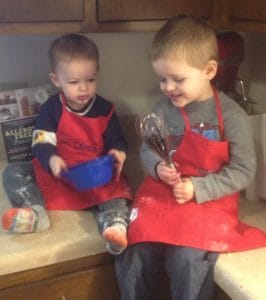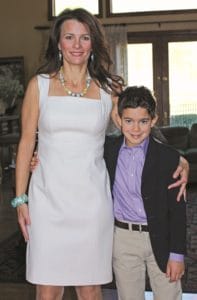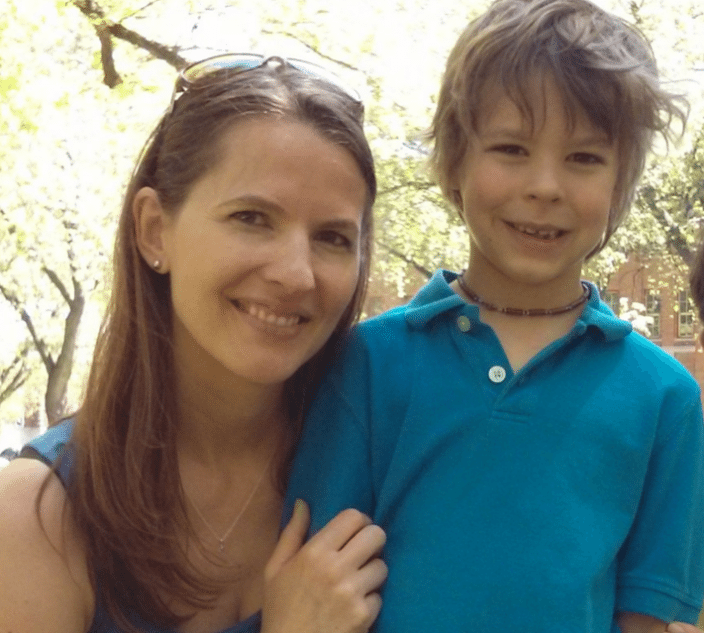Families who endure bad reactions, high anxiety and more to help move food allergy trials forward are often hailed as unsung heroes. This profile of a few such families is from Allergic Living’s Summer 2015 magazine. Subscribe here to receive the magazine and more such articles.
HE WAS a few months shy of 3 years old when Ewan’s mom, Natasha Diamond, witnessed her son’s first severe allergic reaction. His lips swelled and hives broke out and soon morphed into huge welts all over his body. His normally pale skin turned bright red, his ears went purple and when he started to cough, Diamond administered an epinephrine auto-injector to his thigh. That halted the reaction, but the needle sent the boy into a screaming fit. Then, for the next hour, a lethargic Ewan sat, watching “Curious George” on a DVD player and scratching his irritated skin.
To those familiar with anaphylaxis, this episode might seem unremarkable, a worrisome but not uncommon allergic reaction. But this didn’t happen at home or on the playground, or from an accidental bite of peanut in a friend’s snack. Instead, Ewan was in a doctor’s office where nurses were purposely feeding the boy his allergen, to see how much peanut his little body could handle. Ewan is taking part in a clinical trial at the University of North Carolina at Chapel Hill. Doctors there are studying children between the ages of 1 and 4 to see if they can first desensitize them to peanut, then potentially make them tolerant over the long-term; in effect, “curing” them of this allergy.
Diamond knew her son was allergic because of his history with eczema and skin-prick test results that showed allergies to peanuts, dairy and egg. But that day in the clinic was the first time he had actually eaten one of his allergens – Ewan’s first anaphylactic reaction was in the name of science.
Ten years ago, oral immunotherapy and other treatments for food allergies were in their infancy. Researchers postulated that, in theory, having an allergic child consume tiny, then gradually increasing amounts of an allergenic food should help to retrain the immune system, allowing that patient to gain new tolerance to the offending food. After all, this type of therapy was used widely in the allergy shots to treat patients sensitive to environmental triggers like pollens and cat dander.
But making people less allergic to food hasn’t been as easy. Researchers now know that oral immunotherapy, or OIT, won’t work for everyone. When it does work, there are rules and caveats: you can’t exercise after consuming your dose and you might have a greater risk of a reaction if you take your dose on an empty stomach or when you’re sick.
The fact that doctors have learned anything at all about these treatments is thanks to families like the Diamonds. These are the brave parents who sign their kids up for peanut challenges and disrupt their families’ already hectic lives for visits to the clinic. Some travel miles to get to research centers, others have to rearrange work and school schedules. Young children give up extracurricular activities, and courageously endure side effects, such as nausea, vomiting and itchiness.
Researchers at numerous centers are trying different therapies and combinations of therapies in the quest for reliable treatments, so that those with food allergies don’t have to live with the ever-present fear of a fatal wrong bite. Taking the allergen orally, like Ewan does, is one approach. But there are also clinical trials in which patients take the allergen under-the-tongue, through a patch applied to the skin, or in combination with other medications and treatments. It’s more than peanuts being studied, too. Oral immunotherapy trials are underway for milk and egg, and researchers are also studying a patch for milk allergy.
These patients and their families are the test subjects, the ones moving allergic science forward by taking the risks of trying out new and experimental treatments. “We often call them heroes,” says Dr. Hugh Sampson, the director of the Jaffe Food Allergy Institute at the Icahn School of Medicine at Mount Sinai in New York. “They’re willing to go through these therapies in the initial stages when we’re still trying to figure them out.”
Risks Faced Before Rewards
THESE families are also pioneers. Their children are among the first to get treated for a disease for which there previously has been no treatment. While no one is shouting, “I’m cured” from mountaintops, the families for whom the treatments appear to be working are optimistic that they can begin to let down their guard, even just a little bit, and let their children live a more normal life.
For her son Stirling, Sherry Cope desperately wanted to get closer to that reality. His severe allergies were discovered at 14 months when he took a nibble of his older brother’s Ritz peanut butter cracker and immediately started to cry and break out in hives. In the doctor’s waiting room, Stirling’s reaction turned into full-blown anaphylaxis, and a later blood test confirmed he had a severe peanut allergy as well as a tree nut allergy.
The next few years were hard as the Cope family got used to reading every food label, speaking to restaurant managers and educating his preschool.
Originally from England, the family travels back to Europe often. “Flying was a nightmare,” says Cope, since not all flight attendants would ask passengers to refrain from eating peanuts and nuts. At age 5, Stirling had his next serious reaction at a hotel in Spain, when a bartender served peanuts before putting Stirling’s straw in his fruit juice. All it took was Stirling putting his lips to the straw to throw him into a severe anaphylactic reaction, landing him in the hospital overnight.
With such a serious allergy, Cope and her husband lived in fear of accidental exposures and wanted to do something to make their son less allergic. They considered moving back to England to take part in peanut OIT research at Cambridge. But in clinical trials, to prove that the peanut desensitization is actually working, some participants will only receive placebo treatment. Knowing that at the end of two years they might find out Stirling wasn’t actually being desensitized made them reconsider a move.
Then Cope heard about a study in her hometown of Chicago that was enrolling a small number of children. In this study, doctors wanted to see whether giving patients Xolair, an asthma medication taken by injection, before they started the oral immunotherapy would make the treatment more effective. With the study close to home, and knowing that everyone got the peanut (some got a placebo instead of Xolair), the Copes signed Stirling up.
Families who take part in oral immunotherapy and other trials know they are signing up for something with risk. After all, if your child isn’t on the placebo, he will be eating his allergen, the very food you’ve been doing everything in your power to avoid, everyday.
“Virtually all the patients on OIT are going to have some reactions,” says Sampson. “They are typically mild, but if you give your child a dose and afterwards they are complaining about an itchy mouth and an itchy throat, a parent gets very worried because those are often the first signs that they are going to have a significant reaction.”
The studies usually start off with an oral food challenge – the child needs to eat peanut (or another allergen) in a controlled setting to see how much he or she can tolerate before an allergic reaction. “It’s really hard to watch your child, knowing you’re the one putting him through that,” recalls Ewan’s mother.
Skin Patch and the Big Picture
Lianne Mandelbaum wanted to enroll her 9-year-old son Josh in a trial at Mount Sinai Hospital for the patch, called Viaskin, in which a dose of peanut (or milk) is absorbed through the skin. But the initial oral challenge was almost enough to keep Josh out of the study. To be accepted, he would have to, in effect, fail an oral challenge when consuming a small amount of peanut powder. By his second peanut dose, Josh’s stomach hurt, by the third, his throat was on fire. “You’ve told your child he could die if he touches peanuts. Now we’re saying, ‘you have to eat it’. He was very stressed,” recalls Mandelbaum.
In OIT trials, after the initial oral challenge, the doctor sends the patient home with a dose of peanut to take every day. Because children often have an aversion to the foods they are allergic to, getting them to eat it every day is a challenge. “Stirling cannot stand the smell or taste of peanuts,” says Cope. She learned to mix the peanut powder with apple sauce to get the daily dose into him.
Side effects in clinical trials are expected. After some doses, Stirling felt nauseous. At times, he vomited and he’d often get rashes. In Josh’s peanut-patch study, side effects are fewer because the allergen is going in through the skin. Still, the patch is uncomfortable. “It looks like they’ve given him a cigarette burn under the patch. He gets a giant hive underneath,” says his mother. “He scratches, he’s itchy, he’s irritable. But he’s gotten used to it.”
Overcoming Hurdles for the Big Picture
ABOUT three weeks after the start of the peanut-patch trial, Mandelbaum had finally ventured out of the house without Josh for a birthday dinner at a restaurant 10 minutes away. She and her husband had just sat down when their phones rang at the same time. On one line was one of her sons, and the other was the babysitter. The news was that Josh had begun vomiting repeatedly.
Mandelbaum knew it was likely the stomach bug that had been in their house, but knowing one of the signs of anaphylaxis is vomiting, she thought immediately of the patch and the couple rushed home. When she got there, Josh looked up and said, “Please don’t let me die.” His mother promised him his vomiting wasn’t from the allergen patch but still, that night she slept with him, six EpiPens at their bedside.
For Cope, knowing how little of Stirling’s allergen it takes to trigger a big reaction, having him eat peanut was extremely stressful. “It’s so scary at the beginning because we had been through some severe anaphylactic reactions with him,” she says.
Being involved in a clinical trial is also a huge inconvenience. “It can be a very big time commitment, especially when they have other children in the family,” says Sampson. At the beginning of his trial, Diamond had to bring Ewan to the clinic every two weeks to get his next peanut dose. She feels lucky to live only an hour from her study center in North Carolina, but still, that hour drive meant waking her two small children up at 6 a.m. for their 8 a.m. appointment. The cost of gas was a financial burden, and Diamond was nervous driving in morning traffic. Days when Ewan had to get blood drawn also threw a wrench into the day’s nap routine.
Back in New Jersey, Mandelbaum describes the painstaking task of measuring the welts from the patch, which she rotates through 12 spots on her son’s back. “When he takes an old patch off, I have to take a ruler and measure how much beyond the diameter of the patch the reaction is in centimeters. I also have to record when the spot goes away, so I have to go back every day.”
For Stirling, who’s now 12, being in the study has meant he had to give up lacrosse (he took his “peanut medicine” after school, and you can’t exercise for two hours after the dose), and play catch up on any school work he missed when he was at the clinic for the day. “Stirling was determined,” says Cope. “The possibilities of a good outcome were worth the risk of him getting a bit sick or giving up the things he likes to do.”
The Cope family amazingly stuck with Stirling’s trial through a particularly difficult time. Just around the point that he switched from the Xolair part of his trial to the desensitization part last May, Cope suffered a horseback riding accident. “A horse rolled on top of me and crushed the base of my spine,” says Cope. “I was in a wheelchair, I was a mess.” For two months, her husband shuttled between her at one hospital, Stirling’s appointments at Lurie Children’s Hospital, all the while running his own business and taking care of their teenage son.
Despite the inconvenience, the travel and the related costs, families often feel lucky to be involved in the clinical trials. “I really try hard to look at the bigger picture and be thankful that we have this opportunity, that this trial is happening where we live,” says Diamond. In the Mandelbaum family, young Josh feels he’s making a difference for other kids. “Josh feels empowered,” says his mother. “He’s really proud to be participating in the quest for a potential cure for himself and other kids just like him.”
Next: The Life-Changing Results








